You may not immediately notice signs of basement wall bowing. It's usually a slow, gradual process. One of the first warning signs is cracks forming in the wall, which may indicate increasing pressure against your foundation.
A bowed or buckling wall is a critical concern because it compromises the structural integrity of your home. Your entire house relies on a stable foundation, and if left unchecked, a bowing wall can worsen over time. Without proper basement wall repair, the pressure will continue to build, leading to eventual collapse.
Table of Contents
Of course, once a foundation wall collapses, the damage to your home can be severe. Not only will the structure lose stability, but exposure to the elements - rain, mud, and wind - can worsen the situation. Water can seep through cracks, leading to moisture issues, mold growth, and potential foundation settlement.
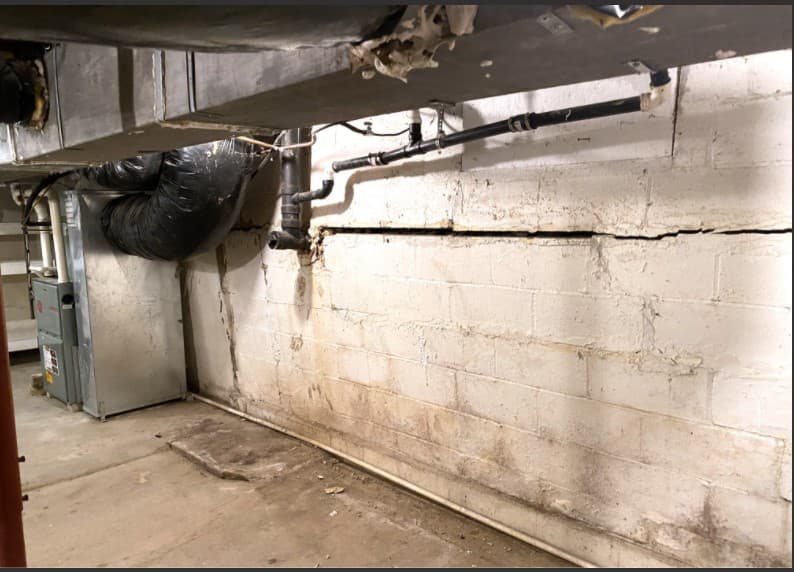
A basement wall bulging inward around a deep crack
(Photo by an Acculevel project advisor during a free home assessment).
Once the main floor is no longer adequately supported, walls may shift, floors can sag, and even plumbing systems may strain under pressure, resulting in burst pipes. At this point, extensive structural work may be necessary, including the rebuilding of your foundation.
At Acculevel, we’re not trying to use “scare tactics” to frighten you. Our goal is to help you address these issues before they become costly and dangerous. If you’re concerned about how to fix bowing basement walls or wondering how to fix a bowing wall, taking action early can prevent further damage and save you from major repairs down the road.
We are foundation repair experts, and we’ve helped more than 30,000 homeowners in the Midwest. Acculevel is a family-owned and operated company that has been repairing, securing, and even straightening bowed or buckling walls since 1996.
Let’s explore some common signs that your wall is beginning to bow, what causes this type of structural damage, and the three major repair methods designed to repair bowing walls.
One caveat: all of the methods described in this article are designed for use on concrete foundations. Stone and brick walls need to be repaired by a masonry expert.
Be on guard for interior cracks in your foundation, as they are one of the first warning signs of bowing walls. These cracks may appear as long horizontal fractures or a stair-step pattern that follows the mortar between blocks.
Below is a picture where you can see both types of cracks.
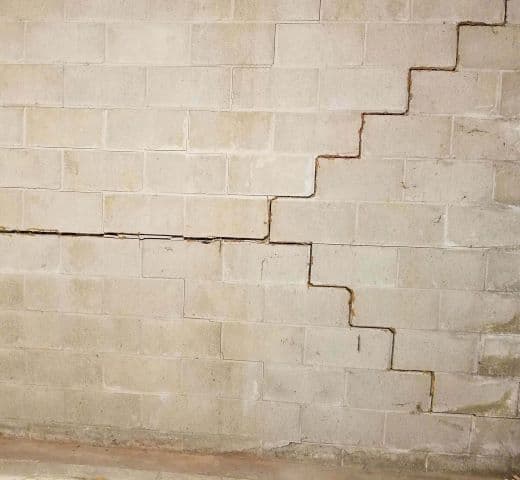
This picture shows a bowing basement wall.
Photo by an Acculevel project advisor during a free home appointment.
These cracks may also be letting in water (moisture intrusion), but water seepage alone isn’t always a symptom of structural failure.
Pay attention to the type of crack and the gradual movement of the wall. These are major warning signs, and indicate increasing pressure against your foundation. Left unchecked, this movement can worsen, leading to serious basement wall repair needs down the line.
If we want to be technical, lateral force is what causes a wall to bow or bulge. But what does that mean for you as a homeowner? Simply put, lateral force happens when the foundation wall is being pushed from the side due to pressure in the surrounding soil.
This is a major problem because your foundation was built to support weight from above, holding and balancing the structure of your home. However, it’s much more vulnerable to side pressure, which weakens the structural integrity of the wall over time. Without proper reinforcement, this can lead to bowing basement walls, cracks, and in severe cases, foundation failure.
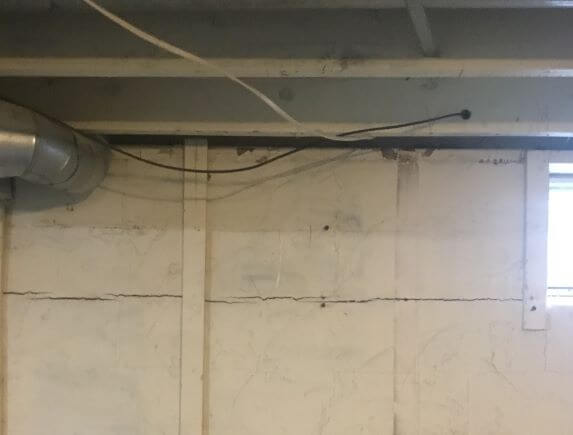
This photo was also taken by an Acculevel project advisor during a free home assessment. The long horizontal crack indicates a bow in the poured concrete wall.
The most common type of lateral force is hydrostatic pressure - a term contractors often use to describe the force created when the soil around your foundation becomes oversaturated with water.
If you frequently have water leaks, or you live near a body of water like a creek or lake, you probably have a high water table. Interior waterproofing is an essential way to reduce hydrostatic pressure, manage any water that gets into your home and could even prevent your other basement walls from being affected in the future.
If you frequently have water leaks, live near a lake or creek, or have noticed humidity and mold issues in your basement, you may have a high water table. Interior waterproofing solutions, such as drainage systems, sump pumps, and foundation sealants, can help reduce hydrostatic pressure. This not only protects against future water damage but can also prevent other basement walls from bowing over time.
Insert: Have more questions? We discuss hydrostatic pressure and how it develops in this article.
We don’t mean to sound evasive, but when it comes to basement wall repair, the best solution depends on the severity of the bowing and what surrounds your home. The more the wall shifts inward, the more invasive and costly the repairs can become. That’s why the earlier you take action, the better it is for the stability of your foundation - and also your budget.
We’d like to make a distinction before we dive into the details. It’s important to clarify that repairing bowing walls doesn’t always mean completely straightening them. The primary goal of these repairs is to stabilize, reinforce, and prevent further structural damage. By securing the wall early, you can restore long-term durability without requiring a full rebuild.
If your goal is to return the wall to plumb (its original upright position), additional steps will be required. Wall straightening involves excavating the soil outside the foundation, allowing a contractor to use hydraulic jacks inside the basement to push the wall back into place. Once the wall is aligned, it is then secured - most commonly with carbon fiber straps.
Wondering about the methods to repair bowed walls? To fix bowing basement walls, reinforcement methods like carbon fiber straps, wall anchors, or helical tiebacks are used. The right solution depends on the severity of the bowing. These methods stabilize the wall, prevent further movement, and restore structural integrity, protecting your home from foundation failure.
It's important to understand that these repairs require professional foundation contractors with experience in structural reinforcement. Attempting a DIY fix of this magnitude is dangerous and may lead to further foundation damage.
The risks of hurting yourself and/or causing major damage to your home are too high. It is essential to hire an expert.
We’ll walk you through the basics of each one and provide you with additional resources for you to explore.
Typically, if your wall is bowing 2 inches or less, a contractor can install carbon fiber straps. They provide structural reinforcement, are the least invasive and least expensive option.
Acculevel installs the best product on the market, manufactured by Fortress Stabilization Systems. These are made of a kevlar material that, once properly secured, should restore your home’s structural stability (both Fortress and Acculevel warranty their strap repairs for the life of your structure.)
To apply the straps, epoxy is used to bond them directly to the basement wall, sealing existing cracks and strengthening the structure. These straps are installed approximately every 4 feet along the wall and require no excavation, making them an ideal choice for homeowners looking for a fast and effective basement wall repair solution.
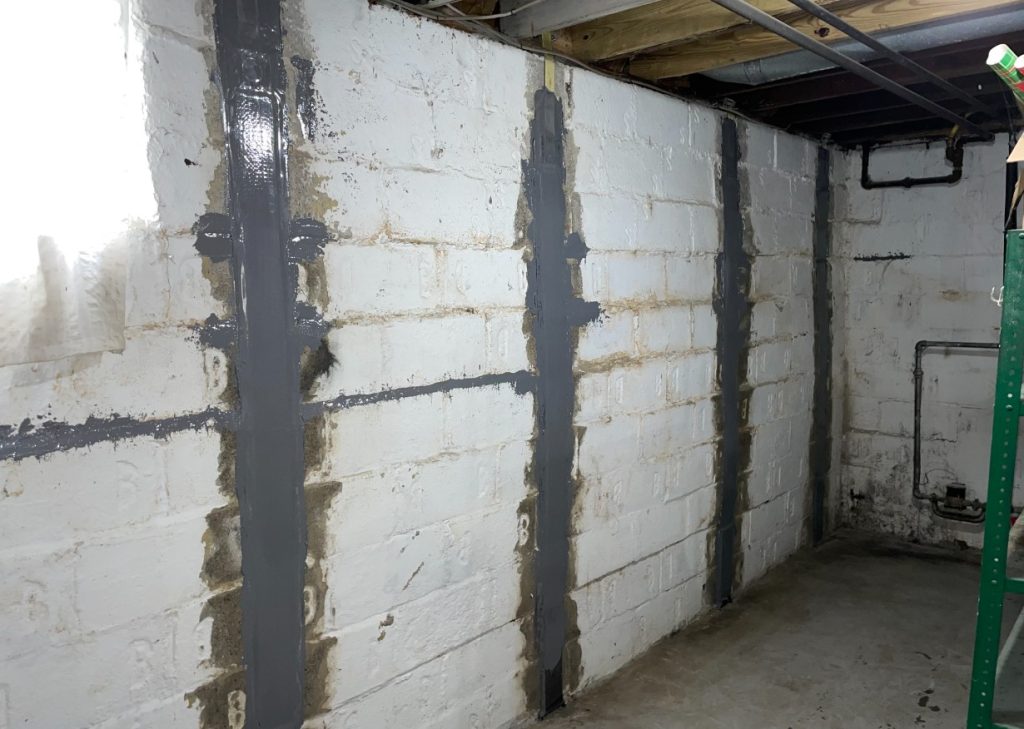
Photo was taken by an Acculevel team member after sealing cracks and installing carbon fiber straps.
(FYI: Once dry, the epoxy can be painted over.)
Learn more about the process in this detailed guide, where we review everything from manufacturing specifications and installation to costs and warranty details.
If your basement wall is bowing more than 2 inches, steel wall anchors may be the best option. This method involves securing heavy-duty steel plates to the interior of the wall, which are then connected to buried anchors outside the foundation. These reinforcement systems help pull the wall back into place and restore its structural integrity. (Acculevel warranties their anchor installations for the life of the structure.)
But to install a wall anchor system, a contractor needs at least 10 feet of accessible ground outside the basement. This means some excavation is required, and obstacles such as decks, porches, sidewalks, or landscaping may need to be temporarily removed or adjusted.
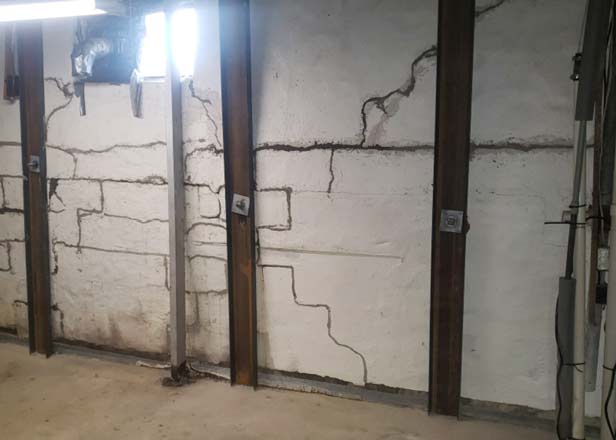
This photo was taken by an Acculevel team member after crack repairs and wall anchors.
A steel plate (or wall plate) is attached to your basement wall, then another plate (the anchor) is buried in the yard. The two pieces are then connected by a steel shaft. As the steel rod is tightened, it exerts pull on the wall and the anchor in the yard holds it fast. Anchors should be placed about every 5 feet along the bowing wall. You can learn more in-depth about wall plate anchors in this article.
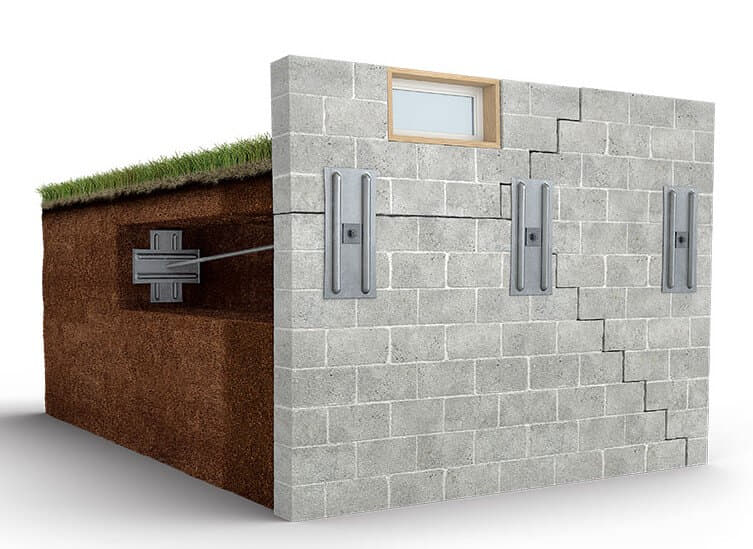
This is an illustration of how to install wall anchors.
If your property is arranged in such a way that anchors are not a good (or legal) option, you’ll need to use tiebacks. A few examples of this would be:
Tiebacks are the most expensive option, but sometimes, they’re the best fit for your home. If your bowing basement wall has shifted more than two inches and your property layout doesn’t allow for traditional anchor installation, helical tiebacks provide a strong, long-term foundation reinforcement solution. Like other repair methods, properly installed tiebacks restore structural stability - and Acculevel guarantees them for the life of your home.
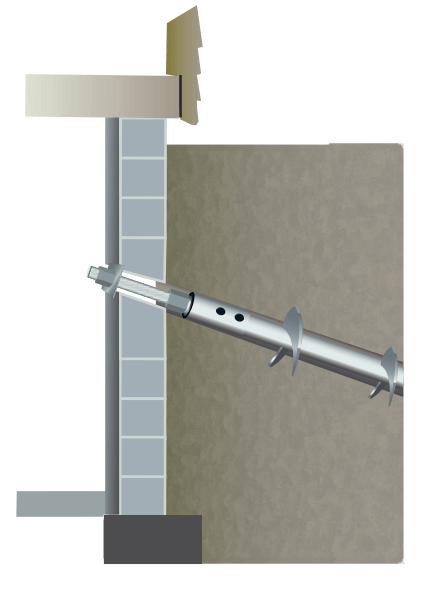
This is an illustration of a Helical Tieback.
A helical tieback is shaped like a screw; it’s a steel shaft with helical blades on it. A hole is made in your basement wall, then the steel post is driven at an angle through that gap into the earth outside of your foundation.
This post is then twisted until it reaches a specific torque that holds it firmly (determined by a pressure gauge). The tieback is then secured to the inside of the basement wall. This is done with a large steel plate, similar to the one used for anchors. This plate is anchored into the floor and extends up to (or near) the top of the wall. Most tiebacks are 14 to 21 feet long, but in certain cases, longer lengths are required to get the proper “grip” or resistance on the soil.
Need more information about anchors vs tiebacks? You can learn more in this article!
When it comes to basement wall repair, waiting too long can lead to costly structural damage. Cracks and bulging walls are early warning signs that shouldn’t be ignored. The sooner you take action, the less expensive and invasive the repairs will be. If left unchecked, a failing foundation can compromise the safety of your home, leading to major foundation instability or even collapse.
If you're wondering how to fix bowing basement walls, the first step is to find a qualified contractor with experience in structural repairs. Not all foundation issues require the same solution, so working with an expert will ensure you get the right approach for your home
You should find a contractor that is reputable, insured, and accredited with the BBB. If you are unsure about how to go about this, we have a detailed list of questions you should ask any home repair contractor.
If you live in Indiana or the surrounding states, contact Acculevel. We have an A+ rating with the BBB and will treat your home as if it is our own.
You can schedule a free estimate at any time. We'll let you know the approximate cost of how to fix a bowing wall, and we’ll make an appointment for you with one of our local project advisors. They will evaluate your foundation repair needs and recommend the best course of action for you to keep your home strong and healthy for years to come.
[DISPLAY_ULTIMATE_SOCIAL_ICONS]